Art and Design Review, 2019, 7, 206-224
https://www.scirp.org/journal/adr
ISSN Online: 2332-2004
ISSN Print: 2332-1997
Analysis of the Narrative Types of
“Metaphor” in Animated Short Films
Hsien-Yuan Chiu, Wei-Lin Chu
Graduate School of Visual Communication Design, National Yunlin University of Science and Technology, Taiwan
How to cite this paper: Chiu, H.-Y., &
Chu, W.-L. (2019). Analysis of the Narra-
tive Types of “Metaphor” in Animated
Short Films. Art and Design Review, 7,
206-224.
https://doi.org/10.4236/adr.2019.74017
Received: October 1, 2019
Accepted: November 2, 2019
Published: November 5, 2019
Copyright © 2019 by author(s) and
Scientific Research Publishing Inc.
This work is licensed under the Creative
Commons Attribution International
License (CC BY 4.0).
http://creativecommons.org/licenses/by/4.0/
Open Access
Abstract
The most presented storytelling medium of animation and film are images.
The narrative messages that viewers obtain through images are much more
rigorous than those from dictation or narration. Therefore, the means to con-
struct story context in an animation narrative is more than the intuitive narr-
ative of character language. Message transmission by hints seems to be an
important technique of image narrative in a plot. Potential messages involve
metaphors in rhetoric. When applied to an image narrative, linguistic tech-
niques have gone beyond the scope of literal modification. Meaning the
viewers’ cognition and past experiences are also involved in the process of
image viewing. Therefore, the metaphors in animated movies are a type of
narrative produced by multiple elements, as well as a mode of deduction
based on real life. According to the related theories of metaphorical mapping,
this study explores the analogical narrative process of images in animation
cases, as based on Gentner’s structural mapping theory and the blending
theory of Fauconnier and Turner. The results of case study show that, in ani-
mated movies, analogies are made through similarities in form, meaning the
attributes of source and target are blended as the means of metaphor, where the
lens movement also contributes to the metaphor of space on the visual psycho-
logical level. In summary, this study is expected to serve as a reference for fur-
ther exploration of the metaphoric narrative of animation in the future.
Keywords
Animated Short Films, Metaphor, Animation Narrative
1. Introduction
A metaphor narrative is one of the techniques to describe a plot story, which
plays an indispensable role in animated movies. In the film context, in addition
DOI: 10.4236/adr.2019.74017 Nov. 5, 2019
206
Art and Design Review
�
H.-Y. Chiu, W.-L. Chu
to the image performance of the main characters, through images, the transmis-
sion of hidden messages increases the aesthetic value of the short narrative in the
film. At the same time, through the description of a metaphor, the viewers can
actively participate in the plot and deduce the story, meaning the image narra-
tive constitutes an interactive media. In fact, every animated movie has the ma-
nifestations of metaphor narrative, such as Ratatouille, as produced by Pixar
Animation Studios (Figure 1), which used black screen and lines to express the
various tastes of delicious foods, and the Castle in the Sky, an animation pro-
duced by Japanese director Hayao Miyazaki in 2002 (Figure 2), which used two
spaces as the hints of human beings’ yearning for an imaginary Utopian and the
essence of human nature.
From the above, we can see that the director elaborated the characteristics of
the event by analogy through the relationship between the scenes, thus, hig-
hlighting the importance of metaphors for the rigor of an image narrative. A
metaphor is a proper noun in rhetoric, which achieves symbolic links through
the process of corresponding patterns by similar psychological analogy (Wen,
2010). There are many related researches on the effect of metaphorical cognition
from multiple dimensions, as well as the ways to transmit the meaning by the
metaphor from the perspectives of cognitive psychology, semantics, etc. The
Source: https://www.comicsbeat.com/michel-gagne-and-ratatouille/.
Figure 1. Ratatouille guides through hints in the back lines.
Source: https://ciatr.jp/topics/32054.
DOI: 10.4236/adr.2019.74017
Figure 2. Another imaginary space beyond reality in the Space Castle in the Sky.
207
Art and Design Review
�
H.-Y. Chiu, W.-L. Chu
DOI: 10.4236/adr.2019.74017
most important classic work Metaphors We Live By, as written by George Lakoff
and Mark Johnson, put forward the concept of metaphors in 1980, which held
that metaphors not only exist in written expression, but also exist in life, thus,
extending the dimensions of metaphor research from linguistics to perceptions,
including visual sense, auditory sense, tactual sense, etc.
However, in terms of visual sense, in 2008, Charles Forceville proposed a way
for images to convey implicit messages, meaning that metaphors may provide
non-verbal information through the expression of dynamic images. While a lot
of literature has analyzed the image metaphor cases in semiotics and advertise-
ments, it is seldom discussed in the field of animation or film. This study takes
the metaphor narrative of animation media as the starting point to explore the
metaphor technique of image media. The commonly used theoretical basises of
the metaphor are: contrast model, feature salience imbalance, conceptual meta-
phor theory, blending theory, structural mapping theory, etc. (Wang, 2012). As
the purpose of animated film itself is to make viewers feel the link between spe-
cific phenomena and practical experience in stylized image manifestations
through image narrative, this paper believes that the blending theory and the
structural mapping theory are suitable theories for the exploration of the basic
framework of image metaphors, where the corresponding image is the metaphor
link. Therefore, this study analyzes the symbols and images in animated movies
on the basis of the above two theories, and analyzes and summarizes how they
are operated and conveyed by rhetorical metaphors and metaphors manifested
by image narratives.
This study attempts to analyze the expression technique of metaphors in ani-
mation by taking the narrative of animated films as the point of penetration, ex-
plores the process of metaphoric reference, and deduces the application of rhe-
toric in images through literature review. Secondly, this study analyzes the link
from the cognition of dynamic images to experience knowledge through a case
study of the mapping relationship between multiple attributes and the meanings
of images. With award-winning cases as the research samples, this study sum-
marizes the forms and techniques of the expression of metaphoric foreshadow-
ing in animation image narratives, and analyzes its mapping relationship, in or-
der to explore the rigor conveyed by images in animation. The purposes of the
study are summarized, as follows:
1) Discuss the application of metaphor rhetoric in animation narratives through
literature review.
2) Analyze the image presentation of metaphor narratives in animation and
films.
2. Literature Review
2.1. From Metaphor Rhetoric to Image Relationship in Movies
Rhetoric itself is a means of description, which makes the text closer to the real
life state or enables the reader to perceive the essence of the text. In order to
208
Art and Design Review
�
H.-Y. Chiu, W.-L. Chu
make the description of the text more precise or more rigorous, different refer-
ence methods are used in language to express some abstract states, such as “time
is money”, “knowledge is power”, etc. The advantage of rhetoric is that it enables
the meaning of language to be understood without specifying all the details
(Gannon, 2001).
Gannon (2001) The point and virtue of particularization is that it enables
language comprehension to take place without the need for message to explicitly
spell out all the details (p. 12).
Metaphoric rhetoric has a specific way of reference in rhetoric. In 1980, Me-
taphors We Live By pointed out that metaphors are a part of life that makes ar-
tistic expression more diverse. From this, we can see that the technique of me-
taphors has been applied in linguistics, as well as an expression approach in real-
ity. In the traditional view, metaphor rhetoric can only be used in speech or text,
but in fact, metaphors can be expressed by images (Sajaniemi & Stützle, 2007).
Sajaniemi, J. & Stützle, T. (2007) Metaphors may appear in several forms.
Traditionally they have been verbal, but they can be pictorial, also (p. 457).
In view of the above, the purpose of conveying expression through metaphors
is to enable the audience to understand its meaning more concretely. Particular-
ly in the field of animation or films, the metaphor is an indispensable means of
narrative aesthetics, which not only gives the manifestation of abstract meaning,
but also motivates the viewers to uncover the context of the story, which makes
the narrative context deeply rooted in the hearts of the audience through the
hidden relationship.
Modern Times, as directed by Chaplin in 1936, begins by describing the back-
ground of the working class, and analogizes crowded sheep with workers in the
next scene (Figure 3), where the characteristics of sheep and the relationship
between the workers in the story describing the same concepts. In the analogy
process of a metaphor, the common attributes of analogy provide the key refer-
ence points. In the application of a metaphor, there are common similarities
between the objects and the base representation, while individual attributes must
be left behind in the mapping process (Gentner, 1983).
Gentner (1983). If the base representation includes concrete objects whose
Source: https://www.youtube.com/watch?v=HAPilyrEzC4.
Figure 3. Analogy between the first and the second scenes of Modern Times.
209
Art and Design Review
DOI: 10.4236/adr.2019.74017
�
H.-Y. Chiu, W.-L. Chu
DOI: 10.4236/adr.2019.74017
individual attributes must be left behind in the mapping, the comparison is an
analogy (p. 161).
It is generally acknowledged that sheep are characterized by obedience, clean-
liness, etc. Even the Bible used the metaphor of a shepherd seeking sheep to refer
to the relationship between Jesus and the people. In this movie, the traits of
workers are obedience to superiors’ orders and continuously working in an un-
questioning manner. In The Cambridge Handbook of Metaphor and Thought,
Gibbs Jr. and Raymond W proposed that, after the extended meanings are found
through the analogical relationship of a Structure-Mapping Engine (SME), it
must also go through the following three discrimination steps: 1) the alignment
process of literal meaning; 2) projection of the inference from base to target; 3)
directional comprehension of the extended meaning of the metaphor.
• Metaphor comprehension begins with a symmetric (nondirectional) align-
ment process.
• If an alignment is found, then further inferences are directionally projected
from base to target.
• Thus, directionality in metaphor comprehension arises after the initial stage
of processing.
(Gibbs Jr., 2008: p.112)
The literal meaning is the original attribute of the object itself. When it comes
to dynamic media, the meaning of the scene can be perceived directly. There-
fore, it is necessary to analyze the original attributes of the sheep and workers in
this case. This paper believes that the analysis of a single picture is not enough to
explain the overall meaning of the scene, but must be inferred through the rela-
tionship of the image meaning in the neighboring sequence, i.e. the neighboring
scenes in the lens. The traits of sheep and workers are analyzed in Table 1.
The table summarizes the relationship between the original attributes and ar-
tistic conception. The form, quantity, and composition of the original attributes
are expressed with similar techniques; therefore, viewers can easily identify the
Table 1. Attribute analysis of sheep and workers.
Analysis item
Sheet
Works
Original
attributes
Lifestyle
Traits
Moving in herds
Operating in groups
Aimlessly obedient; only
moving forward when driven
by shepherds
Operate in accordance with
instructions from superiors, lack
thinking ability, and act in
accordance with instructions
Guide
Shepherd
Boss
Image composition Moving forward in a herd Moving forward in a group
Lens description
Artistic
conception
analysis
The first scene of the movie,
followed by the scene of the
workers approaching the
work place
The second scene of the movie,
followed by continuous scenes of a
large number of workers going to
the work sites of the factories,
clocking in, etc.
210
Art and Design Review
�
H.-Y. Chiu, W.-L. Chu
strong correlation between the two scenes. According to Eco’s point of view, a
symbolic communication system is a communicational framework that conveys
the “code”, which is regarded as the transference of symbolic messages in commu-
nication, and shares some properties during the transference (ECO, 1976).
ECO (1976). Therefore a non-significant system is called a “code” by a sort of
metonymical transference, being understood as part of a semiotic whole with
which it shares some properties (p. 38).
Accordingly, in the case, messages have already been transformed in the form
of symbolic representation, while the individual attributes have been left behind
in the metaphor mapping, as described by Gentner. Furthermore, in the meta-
phoric relationship, the extended meanings associated with the original attributes
must be searched; however, in film semiotics, the extended meanings can be di-
vided into denotation and connotation. Denotation refers to the entire narrative,
including the presentation of narrative elements, the description of people,
things, objects, time, and space, all of which are the scope of discussion of deno-
tation (ECO, 1990). According to the analysis of the above table, denotation is
also the intuitive discrimination of the original attributes, as well as the basis of
the metaphor. Connotation, on the other hand, refers to the overall meaning
arising from the denotative symbols, as proposed by Metz in the case of Que viva
México (Metz, 1964).
Metz (1964). Le langage esthétique a pour signifiant la totalité signifiante-signifiée
d’un langage premier (l’anecdote, le motif) qui vient s’emboîter en lui (p. 83).
Summarizing the theories proposed by Gibbs Jr. and Raymond W, as well as
the denotation and connotation mentioned above, denotation in extended
meaning refers to the expression of literal meaning (original attributes). It is
worth noting that, according to literature, a metaphor as a narrative is a dis-
crimination based on a general phenomenon. In short, a metaphor narrative is
not defined only on the basis of a single phenomenon; instead, it conducts ele-
ment analogy based on the narrative content in the sequence of the scenes. By
editing of the same lens position and composition, Chaplin described the
sheep-like state of the workers directly from form similarity, implying that the
workers are forced to work aimlessly. He also showed the common relation-
ship between the workers and the sheep, and highlighted their similarities
through the pattern and signifier of video pictures. The above analysis con-
firms the extended meanings described by Gibbs Jr., Raymond W, and Eco,
meaning the metaphor is a very important foundation for the nature of origi-
nal attributes. Furthermore, metaphorical performance is a comprehensive
target and base of the whole (Wang, 2012). Therefore, this paper analyzes the
mapping relationship and the signifying process of extended meanings in the
next chapter.
2.2. Operation Process of the Extension of Metaphor Mapping
in Animated Films
One theory of the denotation of metaphors to make deductions using the space
211
Art and Design Review
DOI: 10.4236/adr.2019.74017
�
H.-Y. Chiu, W.-L. Chu
DOI: 10.4236/adr.2019.74017
blending theory, as proposed by Fauconnier and Turner, which states that hid-
den messages are formed by mapping between two different inputs into the final
blended space (Fauconnier & Turner, 2008). Secondly, Gentner’s exposition put
forward that the process of mapping comparison in metaphors is divided into
three stages: first, breaking down and analyzing similarities between sources and
objects to make preliminary matching of their relationship; secondly, combining
cluster models (called “kernels”) into structures for comparison; and thirdly, di-
viding the combined kernels into one or more maximal structures as the result
(Markman & Gentner, 2000).
Stage 1: Local matches.
Stage 2: Structural coalescence into consistent mappings.
Stage 3: Small structures combined into maximal interpretation; candidate in-
ferences (Markman & Gentner, 2000: p. 508).
Gentner further proposed the principle of analogy in two domains: analogy
shall be based on the relationship between the source and the object, rather than
just the attributes of the objects; the specific relationship is determined by the
overall analogy system (Gentner, 1983).
Gentner (1983). Two mapping principles are described: (a) Relations between
objects, rather than attributes of objects, are mapped from base to target: and (b)
The particular relations mapped are determined by systematicity as defined by
the existence of higher-order relations (p. 155).
Both the blending theory and the mapping theory are metaphor theories
based on the mapping of corresponding attributes. In the analysis of animated
movie metaphors, the corresponding relationship between phenomena must be
explored and summarized using the mapping concept. The author summarizes the
analysis of the two theories in Table 2 for subsequent theoretical construction.
Both the blending theory and structural mapping theory discuss the analogy
process of metaphoric analogy, and their viewpoints reveal two metaphor traits:
first, the blending theory emphasizes that, besides the mapping of original
attributes, other channels are also involved in the process to construct the final
blended space; the mapping theory explains that the analogy is made based on
the screened concepts and combined in the mapping process. To sum up the
above theories, a metaphor is a process of analogy by selecting suitable elements,
and then, combining the relevant experience or associative concepts with the
source and target domain. Therefore, to induce metaphorical conditions, this
paper made a case study based on the theoretical model to explore the tech-
niques in animated movies.
3. Research Method
3.1. A Case Study of the Metaphor Rhetoric in Film Images
Balance is a silent animated short film that won the 1989 Academy Award for
Best Animated Short Film. Directors Christoph Lauenstein and Wolfgang
Lauenstein constructed a space to maintain a balance of gravity, as based on the
212
Art and Design Review
�
H.-Y. Chiu, W.-L. Chu
Table 2. Comparison between the blending theory and structural mapping theory.
Name of the theory
Blending Theory
Structural Mapping Theory
Representative scholar Fauconnier and Turner
Genter
Viewpoints of the
theory
Model of the theory
Two distinct input spaces are mapped into a Generic
Space, which contains the original attributes of the two
sources. Moreover, a blended space leaves its own
attributes, and also contains other associative concepts to
make it produce a richer blending space.
The main concepts of source and target are filtered and
integrated one by one in the attribute structure, and then, the
attribute relationship of the metaphor is obtained by matching
the concepts of the source and the target.
Common viewpoints The two theories construct the theoretical analogy model by the mapping process, and emphasize that the process of the
analogical relationship must be mixed with elements other than two attributes. The construction process is not simply a
matching of the relationships between the two attributes.
Different viewpoints The blending theory has two different inputs, indicating that the mapping relationship does not point to a single meaning,
but produces new meaning by the blending the two inputs; the structural mapping theory interprets the corresponding
relationship as mapping to a specific target, indicating that they have a single-point specific metaphor relationship.
concept that the surviving characters must maintain balance between each other.
The treasure box in the narrative implies the benefit or power, etc. desired by
people. The process of fighting between the characters reveals different aspects
of human nature, while the symbols of the treasure box and unbalanced space
are metaphoric references to interests and environments in real life. The author
deduced the metaphoric elements in the plot, as shown in Table 3.
The cognition of a metaphor is not random, but based on the experience of
natural phenomena, or social or cultural cognition, which is enough for metaphor
cognition (Lakoff & Johnsen, 2003).
Lakoff, G. & Johnsen, M. (2003). Such metaphorical orientations are not arbi-
trary. They have a basis in our physical and cultural experience (p. 15).
Furthermore, language is a system of social symbols, while speech is the me-
thod of expression that individuals reorganize according to broad vocabulary
(Chi, 1992). As the meaning of treasure box in experience is wealth, money, as-
sets, resources, rights, interests, etc., after screening out the most reasonable
metaphoric reference of the narrative content according to the broad sense, this
paper conducted clustering and matching according to Gentner’s theoretical
model (Figure 4).
213
Art and Design Review
DOI: 10.4236/adr.2019.74017
�
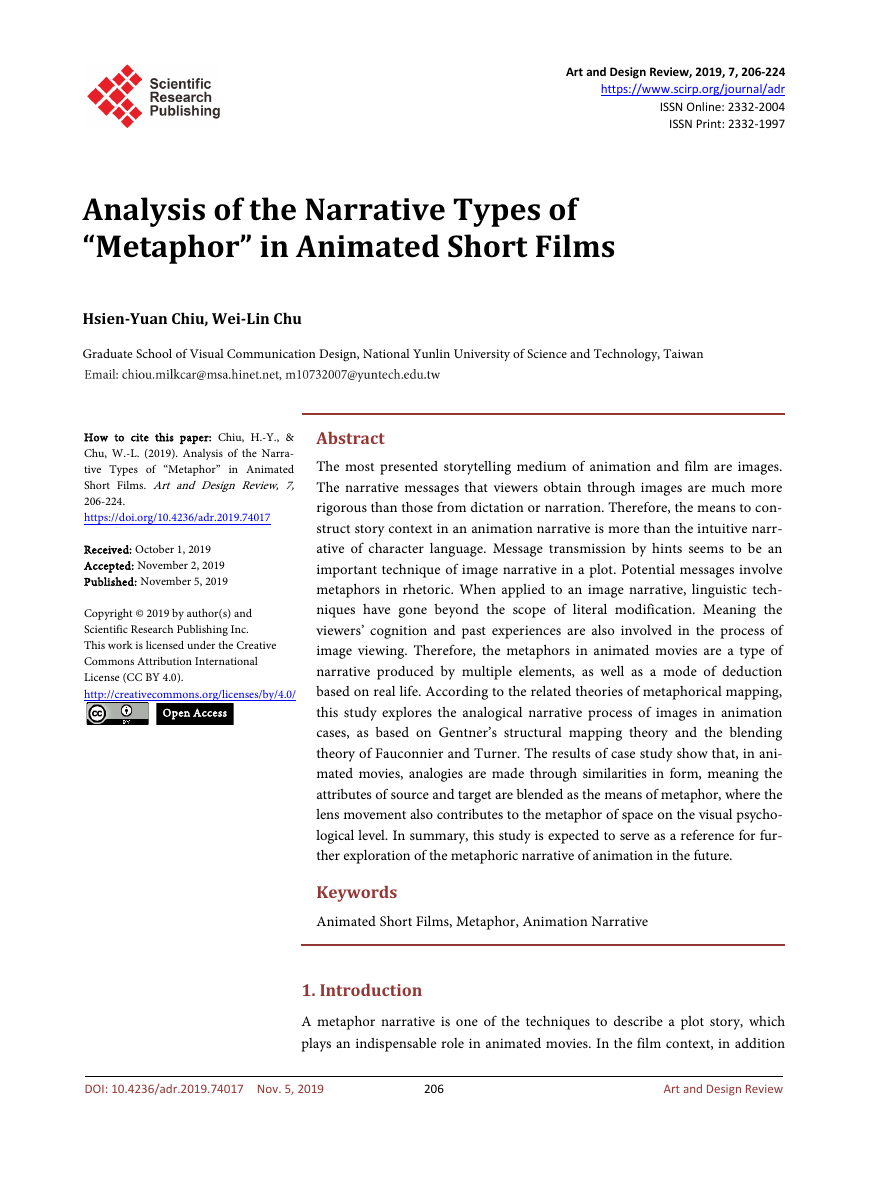
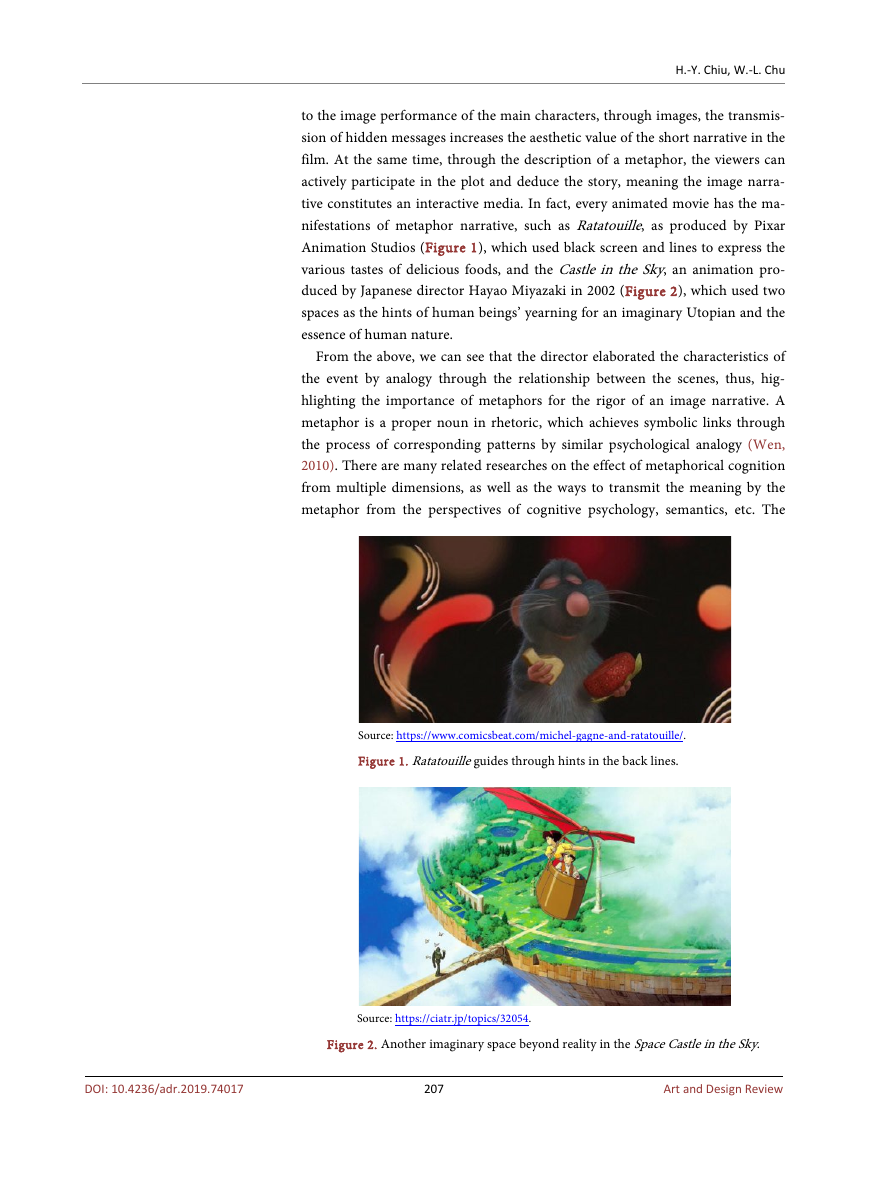
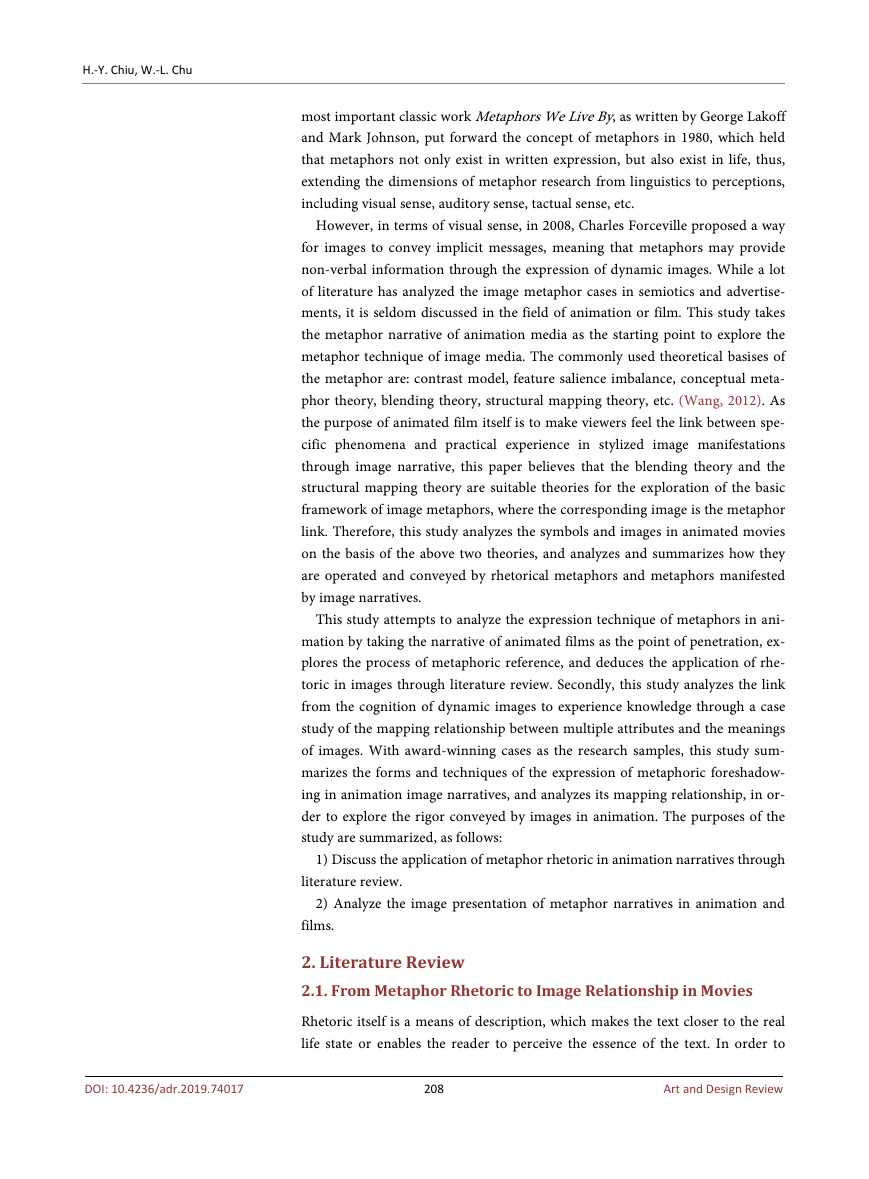

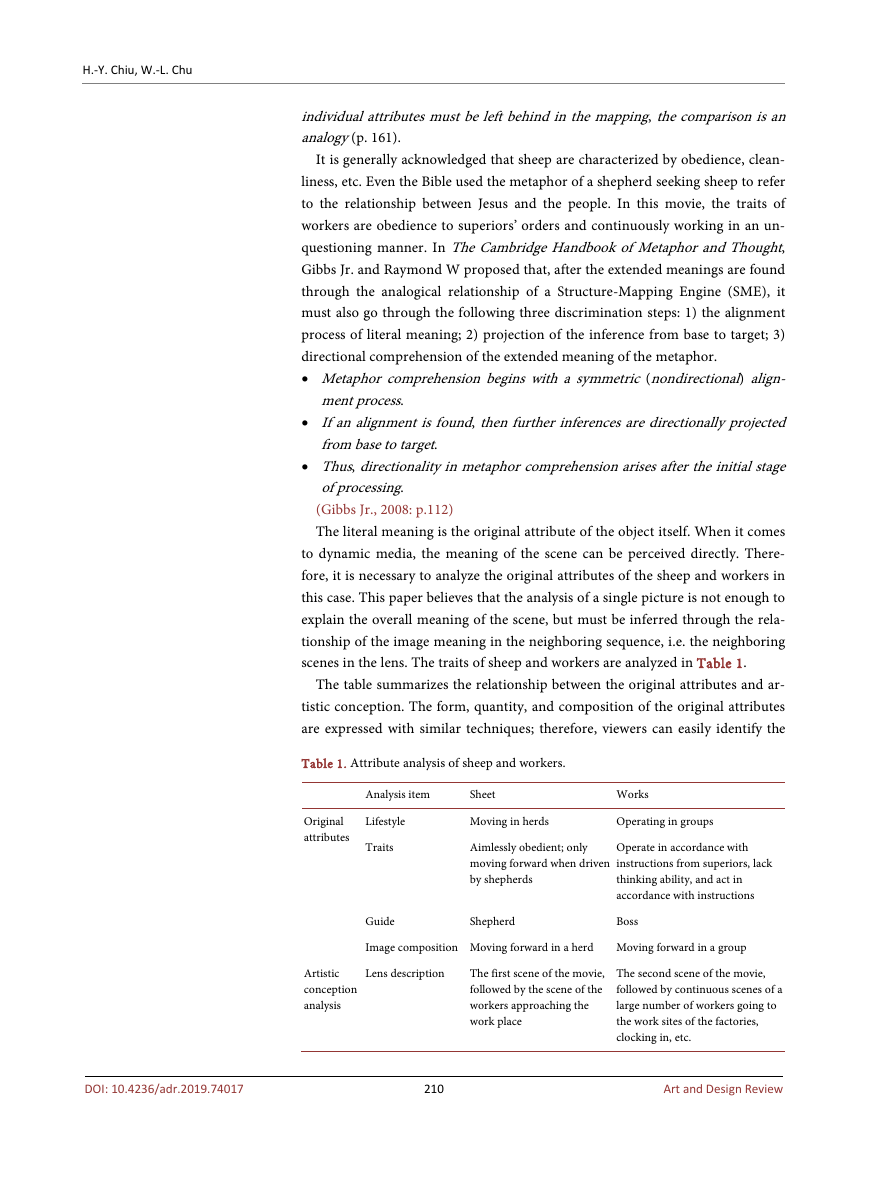

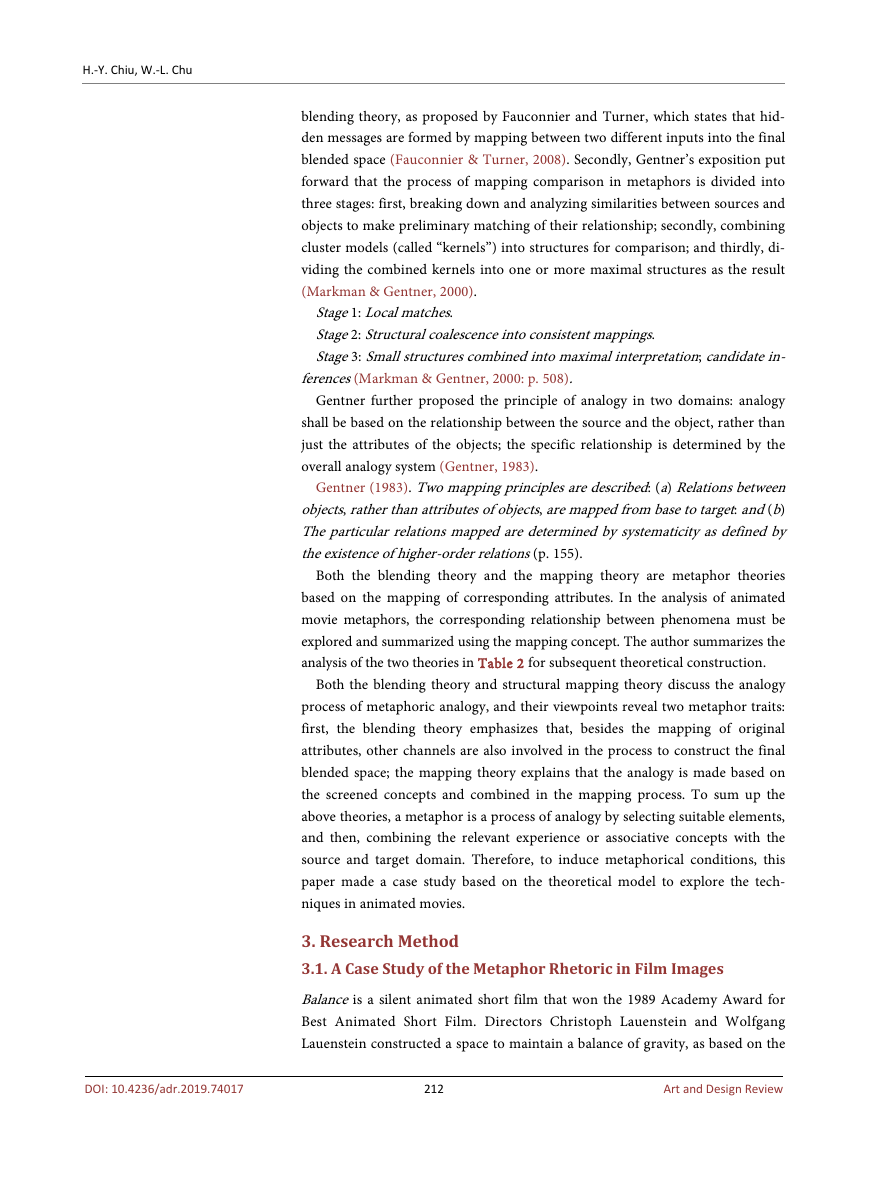









 2023年江西萍乡中考道德与法治真题及答案.doc
2023年江西萍乡中考道德与法治真题及答案.doc 2012年重庆南川中考生物真题及答案.doc
2012年重庆南川中考生物真题及答案.doc 2013年江西师范大学地理学综合及文艺理论基础考研真题.doc
2013年江西师范大学地理学综合及文艺理论基础考研真题.doc 2020年四川甘孜小升初语文真题及答案I卷.doc
2020年四川甘孜小升初语文真题及答案I卷.doc 2020年注册岩土工程师专业基础考试真题及答案.doc
2020年注册岩土工程师专业基础考试真题及答案.doc 2023-2024学年福建省厦门市九年级上学期数学月考试题及答案.doc
2023-2024学年福建省厦门市九年级上学期数学月考试题及答案.doc 2021-2022学年辽宁省沈阳市大东区九年级上学期语文期末试题及答案.doc
2021-2022学年辽宁省沈阳市大东区九年级上学期语文期末试题及答案.doc 2022-2023学年北京东城区初三第一学期物理期末试卷及答案.doc
2022-2023学年北京东城区初三第一学期物理期末试卷及答案.doc 2018上半年江西教师资格初中地理学科知识与教学能力真题及答案.doc
2018上半年江西教师资格初中地理学科知识与教学能力真题及答案.doc 2012年河北国家公务员申论考试真题及答案-省级.doc
2012年河北国家公务员申论考试真题及答案-省级.doc 2020-2021学年江苏省扬州市江都区邵樊片九年级上学期数学第一次质量检测试题及答案.doc
2020-2021学年江苏省扬州市江都区邵樊片九年级上学期数学第一次质量检测试题及答案.doc 2022下半年黑龙江教师资格证中学综合素质真题及答案.doc
2022下半年黑龙江教师资格证中学综合素质真题及答案.doc